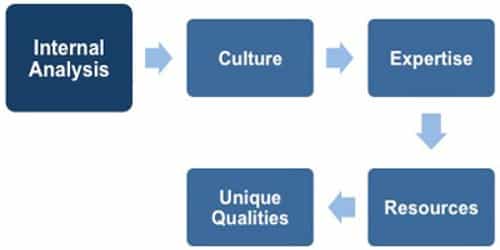Areas covered in Internal Analysis
Internal analysis: A review of an organization’s strengths and weaknesses that focuses on those factors within its domain. It is the procedure of identifying the assets and obstacles that define your company’s potential and limitations.
Internal appraisal evaluates relevant factors in an organization in order to determine its strengths and weaknesses. Typically, every area of the organization that can significantly influence its long-term survival and success should be analyzed. Some of the areas that most organizations should analyze include the following:
- Financial Position
The financial position of an organization plays a crucial role in determining what it can or cannot do in the future. Financial analysis is a comprehensive term that refers to any use of available financial data to evaluate the financial position of an organization.
- Product/Service Position
For a business to be successful, it must be acutely aware of its product or service position in the marketplace. Without this type of information, no business can survive very long in today’s competitive environment.
- Product/Service Quality
Product/service quality has become a major issue in almost all markets today. If a product/service is to survive and grow it must be perceived in the marketplace as providing high quality relative to its price.
- Marketing Capability
Closely allied with an organization’s product position is its marketing capability (i.e., its ability to deliver the right product or service at the right place at the right time and at the right price). Areas that should be investigated regarding an organization’s marketing capability include its distribution channels, the types of advertising and promotions used, and identification of the specific markets being targeted.
- Research and Development Capability
Every organization, whether it has a formal research and development department or not, must be concerned about its ability to develop new products and vice vices. For some industries, such as computers and medical technology, the research and development (R&D) capability of a business is critical if it is to survive. For those businesses in which research and development are crucial, an assessment of what new products or services have been developed by R&D over the past few years should be made. Are any new product(s) or service(s) developed by R&D first in the market, or are they a reaction to a competitor’s new product(s) or service(s)?
- Organizational Structure
All organizations produce and market their products through an organizational structure. This structure can either help or hinder an organization in achieving its objectives. To assess an organization’s internal strengths and weaknesses, its structure must be evaluated. What is the current form of structure and is it effective?
- Human Resources
All the activities of an organization are significantly influenced by the quality and quantity of its human resources. Training programs, compensation systems, performance appraisal systems, and management and employee development programs help determine not only the quantity and quality of current employees but also the type of employee that can be expected in the future.
- The condition of Facilities and Equipment
The condition of an organization’s facilities and equipment can either enhance or hinder its competitiveness.
- Past and Current Objectives and Strategies
In assessing its internal environment, every business should! Attempt to explicitly describe its past and current objectives and strategies. In general, it can be said that past and current objectives and strategies are a strong indicator of future objectives and strategies. Four basic questions need to be answered in this area:
- What have been the organization’s major objectives in the relatively recent past?
- Has it achieved these objectives?
- What strategies has it employed in the relatively recent past?
- Have these strategies been successful?















